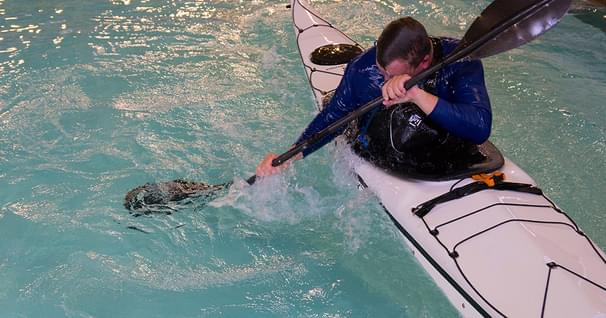Learn To SUP In 5 Minutes
If you're new to paddle boarding, in 5 minutes you can get the tips you need to get out on the water safely and efficiently.
First of all you always want to make sure you're wearing your leash. Don't lift the board straight off the ground, lift it up away from you onto the rail first, so it's standing up on the rail then you can grab the carry handle and lift it up. Don't set the board on down too early, you want to make sure the fin behind you clears the sand. I'm going to put my knees on either side of the handle so I'm evenly over the center line of the board and then I'm gonna take a few strokes on my knees. Then I'm gonna put the paddle in front of me with my hands on the paddle. I'm gonna put my feet right where my knees were, stand up, keep the paddle in the water, look forward and start paddling. You don't want to get stuck in the position like this where you're leaning forward or looking down at the water. That's a very hard position to find your balance. Get your paddle in the water, stand up straight, your chest forward, look look at the horizon, and look at something stable, and then start paddling. For paddle handling, a lot of beginners hold the paddle backwards (which is this way) kind of thinking that intuitively they get more scoop on the water by holding it this way but what happens if you pull it here you can see I'm pulling the water up. So the correct way to hold the blade is angled forward, away from you, that way you get the most power from your stroke. Another mistake beginners make is to hold the paddle to high or when they switch sides hold it at different heights on one side than on the other side. So ideally you want to hold the paddle pretty far apart, That's about the grip height you should have. So another common mistake is making the stroke too far to the side away from the board and holding the paddle diagonally away from the board. If you paddle like this is going to make your board turn left and right. If you want your board to go forward, you want to hold your paddle straight up and down, and pull it straight back in a straight line. If you lose your balance your paddle is like your walking stick. Keep it in the water, it's going to give you extra stability to use that paddle you can kind of lean on it if you are losing your balance, don't put the paddle up here, it doesn't help you at all. What you don't want to do is put the paddle in close to your feet and then pull back behind you. This is kind of wasted energy back here because you're pulling water up instead of propelling yourself forward. So ideally you want to plant the paddle nice in front of you, get the whole blade in the water, and pull it back. Many beginners only use the tip of the blade, not using the whole blade, if you do that the Paddle just slips through the water. So get a nice catch with your paddle, you want to fully plant it in the water and then pull on it, the whole blade should be underwater. So in terms of finding your trim on the board, usually the handle is a good place to orient yourself for where you want to stand. Close to the handle is where the board's going to be flat on the surface of the water. You don't want to be too far forward. When you're too far forward, you might sink the nose or lift up the tail out of the water. The board is not flat on the water surface. If you're too far back, the tail will sink, it's less stable, and you're kind of dragging through the water like this. so make sure you trim out the board by standing right in the center. in terms of safety, make sure you avoid hazards. Right here we have some shallow reef, so I'm very cognizant of where not to go. also wind, especially offshore wind, can be very dangerous, so make sure you always Paddle upwind first, and then coming back will be easy. You don't want to go with the wind and then find out you can't make it back. Always wear a leash for safety, it connects you to the board, so if you fall off, the wind can't blow the board away. You can always get back to shore with your board. If you're doing it for the first time especially, make sure you go somewhere where there's lifeguards or other people that can help watch you. don't go out by yourself, make sure someone knows where you're going. Be aware of the weather and the wind and if that anything changes. going back to the beach, step off carefully with one foot, when you touch the bottom, step off with the other foot, and then again, lift the board up away from you grab the handle, carry the board out of the water like this. Stand up paddling is a really, safe fun sport, low-impact, it's great, improves your balance, it's probably one of the best sports you can do for staying healthy and happy, mentally and physically, so enjoy it, be safe, have fun, like and subscribe below, take care!
Related Articles
Learn how to correctly edge your boat, use proper body position and place your paddle in order to save…
Mention “pool session” and the first image that pops into most kayakers minds is a class in how to roll.…



